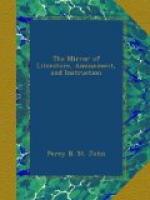“Who invented the oak?”
“The inventers of the science of living in rooms, or chambers—the monks.”
“Ah! they were sly fellows; none but men who were reputed to devote themselves for many hours to prayers, to religious meditations, and holy abstractions, would ever have been permitted quietly to place at pleasure such a barrier between themselves and the world. We now reap the advantage of their reputation for sanctity; I shall revere my oak more than ever, since its origin is so sacred.”
* * * * *
THE NATURALIST.
GLEANINGS IN NATURAL HISTORY.
(Concluded from page 247.)
What a lesson may art learn from contemplating scenes of nature.
The Thrush.
“Thrushes feed very much on snails, looking for them in mossy banks. Having frequently observed some broken snail-shells near two projecting pebbles on a gravel walk, which had a hollow between them, I endeavoured to discover the occasion of their being brought to that situation. At last I saw a thrush fly to the spot with a snail-shell in his mouth, which he placed between the two stones, and hammered at it with his beak till he had broken it, and was then able to feed on its contents. The bird must have discovered that he could not apply his beak with sufficient force to break the shell while it was rolling about, and he therefore found out and made use of a spot which would keep the shell in one position. I do not know whether Mr. M’Adam has ever observed the same circumstance, but his ingenious contrivance (if it is his) of confining stones in a sort of hoop while they are being broken, is somewhat similar to that of the thrush.”
The Pike it seems, is a formidable foe to tackle.
“The boldness of a pike is very extraordinary. I have seen one follow a bait within a foot of the spot where I have been standing; and the head keeper of Richmond Park assured me that he was once washing his hand at the side of a boat in the great pond in that Park, when a pike made a dart at it, and he had but just time to withdraw it. A gentleman now residing at Weybridge, in Surrey, informed me that, walking one day by the side of the river Wey, near that town, he saw a large pike in a shallow creek. He immediately pulled off his coat, tucked up his shirt sleeves, and went into the water to intercept the return of the fish to the river, and to endeavour to throw it upon the bank by getting his hands under it. During this attempt, the pike, finding he could not make his escape, seized one of the arms of the gentleman, and lacerated it so much that the wound is still very visible.
“A friend of mine caught a pike a few minutes after breaking his tackle, and found it in the pike, a part of the gimp hanging out of his mouth. He also caught another, in high condition, with a piece of strong twisted wire projecting from its side. On opening it a double eel-hook was found at the end of the wire, much corroded. This may account for so few pike being found dead after they have broken away with a gorge-hook in them. An account will be found, in ‘Salmonia,’ of a pike taking a bait, with a set of hooks in his mouth, which he had just before broken from a line.”




